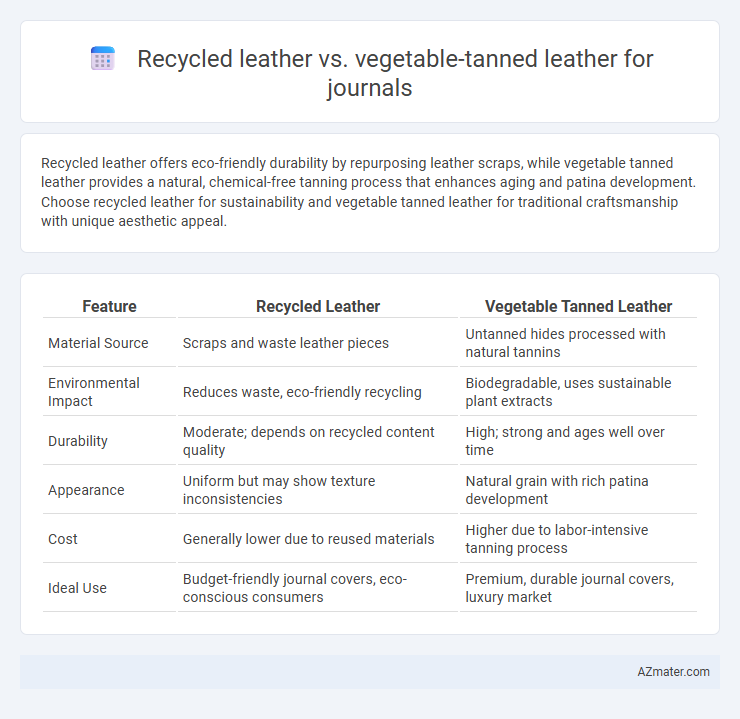Recycled leather offers eco-friendly durability by repurposing leather scraps, while vegetable tanned leather provides a natural, chemical-free tanning process that enhances aging and patina development. Choose recycled leather for sustainability and vegetable tanned leather for traditional craftsmanship with unique aesthetic appeal.
Table of Comparison
| Feature | Recycled Leather | Vegetable Tanned Leather |
|---|---|---|
| Material Source | Scraps and waste leather pieces | Untanned hides processed with natural tannins |
| Environmental Impact | Reduces waste, eco-friendly recycling | Biodegradable, uses sustainable plant extracts |
| Durability | Moderate; depends on recycled content quality | High; strong and ages well over time |
| Appearance | Uniform but may show texture inconsistencies | Natural grain with rich patina development |
| Cost | Generally lower due to reused materials | Higher due to labor-intensive tanning process |
| Ideal Use | Budget-friendly journal covers, eco-conscious consumers | Premium, durable journal covers, luxury market |
Introduction to Sustainable Leather Options for Journals
Recycled leather and vegetable tanned leather represent key sustainable leather options for eco-conscious journal makers. Recycled leather is crafted from repurposed leather scraps, reducing waste and minimizing environmental impact through resource efficiency. Vegetable tanned leather uses natural tannins from fruits, bark, and leaves, offering a biodegradable, chemical-free alternative that ages gracefully with time while supporting sustainable forestry practices.
What is Recycled Leather?
Recycled leather is produced by repurposing leather scraps and fibers from manufacturing waste, which are bonded together using adhesives to create a sustainable and eco-friendly material. It retains the look and feel of genuine leather while minimizing environmental impact by reducing waste and resource consumption. Unlike vegetable tanned leather, which is made through a traditional process using natural tannins from plants, recycled leather emphasizes sustainability through material reuse rather than natural tanning methods.
What is Vegetable Tanned Leather?
Vegetable tanned leather is a natural leather tanning method using organic tannins from tree bark, leaves, and fruits, resulting in a durable and environmentally friendly material. This type of leather ages beautifully, developing a rich patina over time, making it ideal for high-quality journals. Compared to recycled leather, vegetable tanned leather offers superior strength and long-lasting beauty, enhancing the tactile and aesthetic experience of writing.
Environmental Impact: Recycled vs Vegetable Tanned Leather
Recycled leather significantly reduces waste by repurposing scraps and minimizing landfill contributions, making it a more sustainable choice compared to traditional leather. Vegetable tanned leather uses natural tannins from plant materials, avoiding harmful chemicals common in chrome tanning, which lessens toxic runoff and soil pollution. Both options offer eco-friendly benefits, but recycled leather emphasizes waste reduction while vegetable tanned leather focuses on chemical safety and biodegradability.
Durability and Longevity Comparison
Recycled leather offers moderate durability by repurposing leather fibers bonded with polyurethane, yet it tends to wear out faster due to lower resilience and susceptibility to peeling. Vegetable tanned leather, crafted through a natural tanning process using plant extracts, boasts superior longevity, developing a rich patina over time and resisting wear and tear with regular maintenance. For journal covers, vegetable tanned leather provides a more durable and lasting material compared to the more affordable but less robust recycled leather option.
Aesthetic Appeal and Texture Differences
Recycled leather features a unique, worn-in aesthetic with a slightly rougher texture that develops character over time, making each journal cover distinct. Vegetable tanned leather offers a smooth, firm surface with rich, natural tones that deepen and patina elegantly through use. The choice between the two balances recycled leather's eco-conscious charm against vegetable tanned leather's classic, luxurious finish and tactile refinement.
Ethical Considerations in Leather Production
Recycled leather significantly reduces environmental impact by repurposing leather waste, minimizing landfill contribution and lowering the demand for raw animal hides. Vegetable tanned leather, crafted using natural tannins from plant sources, avoids harmful chemicals found in chrome tanning, promoting safer working conditions and biodegradability. Both materials cater to ethical considerations by emphasizing sustainability and reducing the ecological footprint of leather production in journal manufacturing.
Cost and Accessibility Analysis
Recycled leather typically offers a lower cost alternative to vegetable tanned leather, making it more accessible for budget-conscious consumers or large-scale journal production. Vegetable tanned leather, known for its durability and natural aging properties, tends to be pricier due to longer processing times and higher quality raw materials. Accessibility to vegetable tanned leather may be limited in certain regions because of specialized tanning processes, while recycled leather benefits from broader availability via sustainable supply chains and eco-friendly manufacturing.
User Experience and Writing Surface Quality
Recycled leather offers a unique textured surface that provides a vintage, tactile feel ideal for casual journaling, while vegetable tanned leather delivers a smooth, durable writing surface that improves with age, enhancing long-term user experience. The natural oils and fibers in vegetable tanned leather create a slightly firm yet supple texture that supports consistent pen flow without excessive ink absorption or smudging. Recycled leather, with its eco-friendly appeal, may show minor inconsistencies in texture but remains comfortable to hold, making both materials excellent choices depending on user preference for authenticity versus sustainability.
Choosing the Best Leather for Your Journal
Recycled leather offers an eco-friendly option by repurposing leather scraps, reducing waste and environmental impact, making it ideal for sustainable journal covers. Vegetable tanned leather provides durability and develops a rich patina over time, enhancing the journal's aesthetic and longevity with natural tanning methods free from harmful chemicals. When choosing the best leather for your journal, consider the balance between sustainability and traditional craftsmanship, ensuring the material aligns with your values and intended use.

Infographic: Recycled leather vs Vegetable tanned leather for Journal
 azmater.com
azmater.com